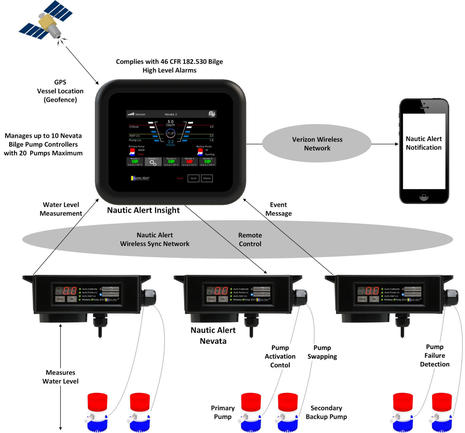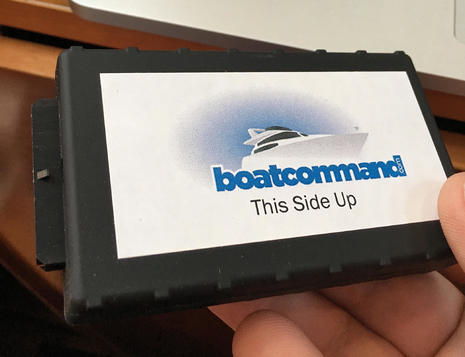Spinlock Sail-Sense, the IoT now includes tacking and flogging
The “Internet of Things” (IoT) concept has not excited me so far. For instance, the oft-repeated example — a wireless sensor/software system by which my ‘smart’ refrigerator will monitor a ‘smart’ milk carton’s level so that my phone can alert me when to buy a new one — leaves me as IoT skeptical as this tech pundit. But when the thing is a valuable sail and Spinlock’s Sail-Sense sensing goes well beyond human capabilities, the IoT story gets interesting.
The Sail-Sense system begins with a small blue hardware module that is most likely stitched onto the clew by the sailmaker, who then uses the Sail-Sense app to pair with the module and input all sorts of information about that specific sail. The boat’s owner or crew could do the same, but they’ll more likely use the Sail-Sense ID’s to keep track of sails piled in serious racing boats or the containers that often follow them around the circuits.
While it’s easy to imagine the Sail-Sense concept working its way down to modest cruising boats — plummeting hardware costs along with massive market growth are IoT assumptions — it’s not surprising to see it begin at the high end.
The Sail-Sense module will have a retail price of £150 ($190) and will include the database features along with tracking a sail’s location and hours of use. But subscriptions costing £25 ($32) per year per sail will be needed to access the modules’ advanced sensing, illustrated below…
- Sail-Sense sail use map
- Sail-Sense sail use archive screen 1
- Sail-Sense sail use archive screen 2
- Sail-Sense live data in Race Mode
The Sail-Sense module wakes on motion and starts carefully sensing that motion as well as UV exposure. And what these screens don’t show are the sail “health scores” that are purportedly calculated using a “fibre analysis of UV and motion” done by a UK university. In other words, the system can not only sense and store hard-to-log data, but make intelligent comments about it.
For more information, visit Smart Sail Systems, the small team that developed this technology before happily turning over exclusive rights to Spinlock, where it was renamed it Sail-Sense. Which makes lots of sense as it may eventually integrate with Spinlock’s other Sense products.





















I’m not a sailor, but I am a geek, so the amount of data this sensor unlocks is pretty exciting to me. This gives me some ideas for similar sensors in other types of propulsion. Could this level of detail be added to a prop shaft to detect prop damage before it’s transmitted up into the transmission? What about on the outside of an engine block to detect changes in running characteristics? It’s pretty darn cool to see what it can do and for $190 it seems like a lot of data.
This has been a common application of strain gauges for many decades. Condition based maintenance is the trendy term used now to describe what has been common in power generation, automotive and aerospace testing and in motorsport.
What is new is low cost sensor availability and the availability of low power wireless communication like Bluetooth low energy. Now for a few dollars (instead of tens of thousands in the 90s)
We’re seeing many interesting innovations, like this, each week. The future for us data addicts is looking good
Hi Ben
Apologies for not replying sooner to your post, but we have been a bit busy recently!
In short, yes, the technology we have developed here in the Sail Sense product can be used for a huge number of other applications. It’s just that we started with sails. Our main focus for 2019, whilst supporting Spinlock, is to investigate all the other industries where our tech could solve an existing problem. As you say, motors and pumps are an obvious one (we are already talking to several people about this). Monitoring accelerations in seats of tractors, diggers, forklifts as well as high-speed Ribs (motor boats). All these applications will use the same basic hardware with just some small changes to the software and firmware, which is really exciting for us!
Ben,
Vibration analysis is a very standard technique on large (I.e., expensive) marine engines. The transducer hardware is cheap, the analysis is the hard part. Software that was smart enough to learn the vibration characteristics of an engine, and then alert to a change would be nice. Really nice would be software that could look at 3 axis vibration pattern and suggest (intelligently) that the problem is an engine mount, prop issue, missing cylinder, turbo breaking, etc would be really nice.
What you want has been in common use for decades in motorsport. As the cost is dropping and machine learning is now becoming affordable I suspect we’ll see lots of innovation in this space.
Leftbrain is right 😉 Condition based maintenance. Love to have some of that for my 3GM30F at a reasonable price point.
I like the term “condition-based maintenance” a lot, especially since it could also be called “smart maintenance.”